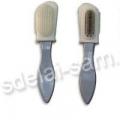Didactic game "Clock and time. How to teach a child to tell time by clock quickly and easily Learn time by clock games
The world around for a child is an exciting fairy tale full of adventures, magic and surprises. He quickly masters it, learns to understand the basic laws and rules. Parents pay more attention to such intellectual skills of the baby as logical thinking, development of speech, learning to write or read. But it is also very important to teach the child to navigate in time, to understand what minutes, days are. For this, training watches that you can buy on our website are perfect.
When should you buy a training watch?
What is time, the child already confidently knows in 1-2 years. But for now, for him, it's just a round plate with arrows on the wall, which ticks merrily. He recognizes the alarm clock in the picture in the book, he likes to play, putting a shiny watch on his father's hand. But he still doesn't know how to navigate them. When should you buy them and how to teach him to tell the time?There is no one universal method. Many kids already at 1-1.5 years intuitively understand the sequence of events (in the morning we get up and go to the kindergarten, and it will be possible to play in the afternoon; dad comes in the evening when the sun has already set). But what is a minute or other unit of time, they do not know. They do not associate certain events in their lives with a specific time. This manual for them can become just another beautiful, but incomprehensible toy.
How does a child see time? "When my mother and I were walking in the park, I saw a pigeon", "I was upset when Sasha went home before anyone else." You need to start acquaintance with the training clock when the baby already understands and uses other temporary categories:
- "before" and "after" (I get up, my mother prepares breakfast, and then we go to the kindergarten, after sleep my father picks me up, after bathing I watch a cartoon);
- morning, evening, day, night;
- days of the week, seasons.
Educational hours for the little ones: how to work with toddlers
The easiest way for a child to perceive time is if he has a certain daily routine. You can use the learning clock for toddlers as a game. First, study the dial, find all the familiar numbers. Ask the child to run their finger from 1 to 12, calling them in order. Ask where the arrow will run. The direction of movement of the arrow is not easy to remember, but after that things will go smoothly.Play with the learning clock using only one, smaller hand. Let the child simply remember where the numbers are placed and learn to call them (the hand at 3 is three o'clock, afternoon tea time!).
The next task is to help him understand the passage of time. Put the arrow on eight. It's morning. Now our baby will wake up. In 30 minutes he should be in the kindergarten. When it will be? Rotate arrow. And after three or four divisions there will be lunch. How to run with an arrow?
You can work with minute hands already at the age of 4-5, if the preschooler knows the numbers well and understands how time goes, why twelve is both midnight and noon. This manual will be a great help for you in this difficult task.
In our online store you can buy educational watches for the little ones, board games with them, nature calendars, materials for learning the days of the week. The range of goods is very large, everyone can choose useful benefits for their baby here.
Within the framework, let's talk about a children's educational game: "Watches: Learning to determine the time by the arrows."
As it turned out, it is very pleasant to write a review for a children's game. This is probably due to the fact that in such games they do not shoot, there is no blood, and a pleasant design.
And now about everything in order:
Requirements
iOS: 5.0 or later, 47.6 MB free space. Suitable for: iPhone, iPad and iPod touch. Application in Russian. Age 4+
Briefly
With the help of this game, the child will learn to tell the time by the usual clock with arrows.
in detail
Here is what experts say about children and time:
You can start teaching a child to tell time from the age of 5, when he understands what a sequence of events is. He knows the past, present and future. He understands that after day comes night. For training, buy a toy clock or make your own. Watches should have a large dial and easily removable hands.
You can do this, or you can download the Clock app.
The game has three difficulty levels. At its simplest, a sweet female voice will ask the child to set the hour hand so that it matches the task. Along with this, at first (until the child learns), the correct arrangement of the arrows will be highlighted with a dotted line.
As the child learns, the levels will begin to get more difficult. It will be necessary to set not only the hour hand, but also the minute hand. It is difficult to add something else about a simple application, it is worth noting that the developers really tried on the design and sound design. Everything is done at a very high level. The application is paid, the price is 33 rubles.
Gift
The developer kindly provided the codes :-) Good luck!
Parents used to draw a clock face on cardboard for their children, or shake the clock in front of them, trying to explain what a time line is and why there are seven days of the week. This set includes the maximum effective ways study the time, days of the week and seasons, teach the child to build his own plan and calendar. It was developed by the methodologists of the School of the Future, so with it your child is ahead of the rest.
Opening the box
And in it is a conveniently lined magnetic board, similar to the page of some cool mobile application: a clock, a calendar, and other slots that the child will fill in on their own. You can even draw on it, not only place magnets.

The workbook contains theory, practice, various tasks, and illustrated exercises. It can be gradually dealt with, starting with the simplest. Moreover, children can do it on their own, their older brothers and sisters with their parents can only help a little with reading assignments.

Games allow you to make the learning process interesting and exciting, and changing activities for a long time does not tire even the smallest children. Take the cards and match the magnets with the photos of nature with the time of year or day. Discuss what you are doing today, what you did yesterday, and what plans for tomorrow - this is how a child realizes the existence of different planes of reality through pictures.
There's a lot in the box
- The cover from the inside is a magnetic board, specially lined for the necessary tasks,
- Magnetic dial with arrows,
- 10 cards with good examples change of times and seasons,
- 27 magnets with days of the week, months and symbols,
- Workbook with training program,
- Blue and black markers with erasers.


Adults can easily determine the time by the clock, but for a child this mechanism is completely unfamiliar, the baby does not understand why the numbers are drawn on the device and why the arrows move. But the ability to understand time - one of the most important skills, without which an independent life is not imagined.
How rather a child learns how to tell time by the clock, the faster he will become independent and learn how to organize his time. In order to teach a child to understand time in an accessible and understandable way, it is important not to rush and start with the simplest concepts.

girl and watch
Why and when should a child be taught to tell the time by the clock?
If we imagine that an adult person does not know how to navigate in time, then he will not be able to understand when he should go to work, when to return from work, what time lunch or dinner will come.
So it is difficult for a child who does not know the concept of hours and minutes to determine when his parents will pick him up from kindergarten. Therefore, the baby can be capricious when he is asked to wait five minutes - because he does not understand how much it is - what if, all day?
When the child is already at the age when he can stay at home alone, mom or dad will warn him that he will be back in 2 hours. But without the ability to determine the time on the clock face, the baby may be confused and frightened by the fact that he does not know when his parents will come.
Therefore, it is important to teach your child to navigate by the clock in a timely manner. This will help him become more disciplined and ready for grade 1 at school.
No specific age when can you start learning. To begin with, the child must be able to count to at least 60 and know how these numbers look. Some children learn this already by the age of 5, others a little later - by 6 or 7.
A child who understands hours and minutes will already wear a watch not only as an accessory, but also as a time orientation device. That will help him be more confident and punctual.


Where to start learning?
Time for a child is the concept of something indefinite, non-existent, because it cannot be touched or touched. Of course, children understand that life is moving forward, but it is still difficult for them to formulate this thought.
Learning to determine the time by the clock should be gradual, from small to large, so that the child does not have confusion in the head.
To begin with, it is worth explaining to the child what time is, which is called the future, present and past. You can remember these concepts with the help of the simplest examples from life. For example:
- yesterday we were visiting grandfather - this is the past;
- now we are playing in the park - this is real;
- tomorrow morning we will go to Kindergarten is the future.
Examples should be given as simple as possible, which are understandable and interesting to a small person, then he will quickly learn and assimilate the basic concepts of time
You also need to teach the child to easily understand all seasons and name their main features. For example, if snowing It means winter has come. When the flowers bloom and the grass turns green, it's spring. In the summer the sun is hot and you can eat ice cream, and in autumn the birds fly south and the leaves fall from the trees.
When the baby learns about the seasons, you need to jump to month names. He must learn well which season this or that month belongs to. Then explain that a month has 28, 29, 30 or 31 days, and that it consists of weeks that have 7 days.

Calendar for learning the seasons and months
Let's move on to the concept of minutes and hours
When the child clearly understands the seasons, months, weeks and days of the week, you can start talking about hours and minutes. The easiest way to explain this is with simple real-life examples.
To begin with, invite the baby to remember how his day begins - in the morning, when he wakes up, has breakfast and goes to the kindergarten. Then the day comes, and with it lunch and a quiet hour, and after the evening, when everyone has supper and gone to bed, night comes.
Here it is necessary to explain that morning, afternoon, evening and night generally referred to as days. And every day lasts the same - 24 hours. And in order to know when to get up, have lunch or pick up the child from kindergarten, parents determine everything by the clock.
Show the child an ordinary second watch and ask him to tell what he sees on them. Hours for teaching children should be with prominent numbers and with divisions of minutes. Then offer to count all the small dashes - there will be 60 of them, and they are called minutes. When the largest arrow passes the circle, one hour passes, and if it is small, then one minute.
Since children learn best while playing, you need to make a layout of the clock face with arrows together with parents.
To do this, you need to cut a circle out of thick cardboard, draw a clock face on it and color it, write the numbers in bright colors. Cut out the hour and minute hands from cardboard and attach to the center of the clock so that they can move freely (for example, using a pushpin or a bolt).

An example of a homemade dial
Learning Steps on the trainer:
- Motivation - to explain that a person needs a watch so that he is not late and has a lot of time.
- Acquaintance - to tell what a dial is, that the hands move only in one direction and together answer the question why there is no reverse for time.
- Start with integers. For convenience, leave only the large hand on the dial and work with the clock, then attach the minute hand and find out how it differs from the hour hand. To make it easier for the baby to understand the time, you can draw an activity near each hour: breakfast, sleep or games - so that the pictures match the child’s daily routine.
- Try to determine the time by setting simple values \u200b\u200bin small intervals on the dial. For example, 3:10 or 4:30.
When the baby becomes free to determine the 5-minute intervals, you can complicate the task and explain how the clock will look like 12:17 or 9:37. Invite the child to put the arrows himself at the time when he goes to bed. And in the morning, the parents will move the arrows, and the baby will name the time at which he woke up.

Child learns to tell time
Consolidation of new knowledge in a playful way
When the child learns to use the regular and training dial, and will call what time it is, this success is worth reinforcing from time to time. Be sure to contact him with questions such as:
- tell me, please, what time is it?
- Dad said he'd be back in half an hour. How long will it take?
- you woke up at 8 o'clock, and now it's 8.30 - how long has it been?
- Remind me to call grandma in 15 minutes.
It is useful to purchase a real wall clock in the baby's room and place it in the most visible place.
When the child confidently answers the question: “What time is it?”, You can begin to get acquainted with the second hand. For clarity, it can be explained that a second passes in one clap. You should not rush the baby, but to say commendable words is a must. All children need a different amount of time to begin to understand the clock.
How to help your child navigate the clock with the help of games:
- Set up a daily routine- put the arrows on the clock layout at the time when the child wakes up. Move them around and say together what he does at one time or another of the day.
- Set the hands to any time and ask the question: “Is it right that it is now 2 hours 10 minutes?” The child must confirm or refute what has been said. If he finds it difficult to give an answer, prompt with leading questions.
- Play Bus Station- determine what time the car should leave and put the arrows at the right time. First, pronounce the time in whole numbers, and then complicate the task by naming such definitions as a quarter of an hour, noon.

Children's watch with images of the daily routine
It is necessary to teach children to value time and manage it correctly from childhood. Periodically ask what useful or good deed can be done in one minute, half an hour or an hour. Do not hope for quick results and in no case rush the child, as time orientation is one of the most difficult skills. How younger child, the shorter the session should be. And when the baby begins to understand minutes and hours, it is worth buying bright colors for him. wrist watch- then he will begin to quickly apply the knowledge gained in practice.
You will learn how to teach a child to tell the time by the analog clock by watching the video:
August 26, 2018, 17:11
 How and how to clean suede shoes, suede boots, shoes, shoes from white stains, dust, stains, greasy and scuffed at home with folk remedies and shoe care?
How and how to clean suede shoes, suede boots, shoes, shoes from white stains, dust, stains, greasy and scuffed at home with folk remedies and shoe care? Remove varnish from the wall with folk remedies
Remove varnish from the wall with folk remedies Effective carpet cleaning at home
Effective carpet cleaning at home